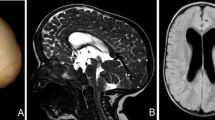Abstract
The occurrence of secondary synostosis of coronal sutures at distance from H-craniectomy surgery for scaphocephaly concerns about 10% of children. Intracranial hypertension in these children remains exceptional but generally requires a surgical reoperation. Two children aged 3 and 5- months- old had been operated for scaphocephaly by H-craniectomy in two different hospital centers. Their clinical follow-up described a partial persistence of dolichocephalic deformity and an impression of parietal stenosis. During their growth, chronic headaches appeared with a complaint expressed at the ages of 4 and 5 years. In both cases, ophthalmic examination revealed significant bilateral papillary edema without loss of visual acuity. The imaging assessment (CT-scan and MRI) showed the absence of Chiari malformation and venous abnormality. For both, there was a compression image of the parietal lobes in relation to the persistence of a temporoparietal synostosis. An osteogenic parietal distraction permitted a volumetric brain expansion consecutive to the skull and meninges remodeling in only 6 months, associated with a leap forward acquisition, a normalization of the ophthalmic examination, and a complete loss of headaches. In conclusion, this new approach could be used in the case of chronic intracranial hypertension consecutive to a secondary parietal synostosis after a scaphocephaly surgery.


Similar content being viewed by others
References
Antúnez S, Arnaud E, Cruz A, Marchac D, Renier D (2009) Scaphocephaly: part I: indices for scaphocephalic frontal and occipital morphology evaluation: long-term results. J Craniofac Surg 20(2):1837–1842. https://doi.org/10.1097/SCS.0b013e3181b6c4ea
Arnaud E, Capon-Degardin N, Michienzi J, Di Rocco F, Renier D (2009) Scaphocephaly part II: sSecondary coronal synostosis after scaphocephalic surgical correction. J Craniofac Surg 20(2):1843–1850. https://doi.org/10.1097/SCS.0b013e3181b6c4c3
Kuang AA, Jenq T, Didier R, Moneta L, Bardo D, Selden NR (2013) Benign radiographic coronal synostosis after sagittal synostosis repair. J Craniofac Surg 24(3):937–940. https://doi.org/10.1097/SCS.0b013e31828dcf24
Cetas JS, Nasseri M, Saedi T, Kuang AA, Selden NR (2013) Delayed intracranial hypertension after cranial vault remodeling for nonsyndromic single-suture synostosis. J Neurosurg Pediatr 11(6):661–666. https://doi.org/10.3171/2013.3.PEDS12525
Lam S, Wagner KM, Middlebrook E, Luerssen TG (2015) Delayed intracranial hypertension after surgery for nonsyndromic craniosynostosis. Surg Neurol Int 6:187. https://doi.org/10.4103/2152-7806.172532
Christian EA, Imahiyerobo TA, Nallapa S, Urata M, McComb JG, Krieger MD (2015) Intracranial hypertension after surgical correction for craniosynostosis: a systematic review. Neurosurg Focus 38(5):E6. https://doi.org/10.3171/2015.2.FOCUS14853
Thomas GP, Johnson D, Byren JC, Judge AD, Jayamohan J, Magdum SA, Richards PG, Wall SA (2015) The incidence of raised intracranial pressure in nonsyndromic sagittal craniosynostosis following primary surgery. J Neurosurg Pediatr 15(4):350–360. https://doi.org/10.3171/2014.11.PEDS1426
McMillan K, Lloyd M, Evans M, White N, Nishikawa H, Rodrigues D, Sharp M, Noons P, Solanki G, Dover S (2017) Experiences in performing posterior calvarial distraction. J Craniofac Surg 28(3):664–669. https://doi.org/10.1097/SCS.0000000000003458
Satanin L, Teterin I, Sakharov A, Roginsky V, Serlo W, Salokorpi N (2012) Experience with resorbable sonic pins for the attachment of distraction devices in posterior cranial vault distraction operations. Childs Nerv Syst 35(5):851–856. https://doi.org/10.1007/s00381-019-04097-0
Wiberg A, Magdum S, Richards PG, Jayamohan J, Wall SA, Johnson D (2012) Posterior calvarial distraction in craniosynostosis - an evolving technique. J Craniomaxillofac Surg 40(8):799–806. https://doi.org/10.1016/j.jcms.2012.02.018
Massimi L, Di Rocco C (2012) Mini-invasive surgical technique for sagittal craniosynostosis. Childs Nerv Syst 9:1341–1345. https://doi.org/10.1007/s00381-012-1799-4
Nowinski D, Di Rocco F, Renier D, SainteRose C, Leikola J, Arnaud E (2012) Posterior cranial vault expansion in the treatment of craniosynostosis. Comparison of current techniques. Childs Nerv Syst 28(9):1537–1544. https://doi.org/10.1007/s00381-012-1809-6
Simpson A, Wong AL, Bezuhly M (2017) Surgical cCorrection of nonsyndromic sagittal craniosynostosis: concepts and controversies. Ann Plast Surg 78(1):103–110. https://doi.org/10.1097/SAP.0000000000000713
Kyutoku S, Inagaki T (2017) Review of past reports and current concepts of surgical management for craniosynostosis. Neurol Med Chir (Tokyo) 57(5):217–224. https://doi.org/10.2176/nmc.ra.2017-0006
Genitori L, Lang D, Philip N, Cavalheiro S, Lena G, Choux M (1992) Cranioectodermal dysplasia with sagittal craniosynostosis (Sensenbrenner’s syndrome): case report and review of the literature. Br J Neurosurg 6(6):601–606
Denis D, Genitori L, Bolufer A, Lena G, Saracco JB, Choux M (1994) Refractive error and ocular motility in plagiocephaly. Childs Nerv Syst 10(4):210–216
Genitori L, Zanon N, Denis D, Erdincler P, Achouri M, Lena G, Choux M (1994) The skull base in plagiocephaly. Childs Nerv Syst 10(4):217–223
Denis D, Genitori L, Conrath J, Lena G, Choux M (1996) Ocular findings in children operated on for plagiocephaly and trigonocephaly. Childs Nerv Syst 12(11):683–689
Schmidt BL, Kung L, Jones C, Casap N (2002) Induced osteogenesis by periosteal distraction. J Oral Maxillofac Surg 60(10):1170–1175
Zhao D, Wang Y, Han D (2016) Periosteal distraction osteogenesis: an effective method for bone regeneration. Biomed Res Int 2016:2075317. https://doi.org/10.1155/2016/2075317
Delashaw JB, Persing JA, Jane JA (1991) Cranial deformation in craniosynostosis. A new explanation. Neurosurg Clin N Am 2(3):611–620
Opperman LA (2000) Cranial sutures as intramembranous bone growth sites. Dev Dyn 219(4):472–485. https://doi.org/10.1002/1097-0177(2000)9999:9999<::AID-DVDY1073>3.0.CO;2-F
Kuang A, Selden NR (2015) Secondary cranial vault remodeling for restenosis after primary sagittal synostosis repair. Pediatr Neurosurg 50(2):104–108. https://doi.org/10.1159/000380768
McMillan K, Lloyd M, Evans M, White N, Nishikawa H, Rodrigues D, Sharp M, Noons P, Solanki G, Dover S (2017) Experiences in performing posterior calvarial distraction. J Craniofac Surg 28(3):664–669. https://doi.org/10.1097/SCS.0000000000003458
Esparza J, Hinojosa J, García-Recuero I, Romance A, Pascual B, Martínez de Aragón A (2008) Surgical treatment of isolated and syndromic craniosynostosis. Results and complications in 283 consecutive cases. Neurochirurgia (Astur) 19(6):509–529
Acknowledgements
We are grateful to co-authors for the rereading of the article.
Author information
Authors and Affiliations
Corresponding author
Ethics declarations
Conflict of interest
The authors have nothing to disclose.
Additional information
Publisher’s note
Springer Nature remains neutral with regard to jurisdictional claims in published maps and institutional affiliations.
Rights and permissions
About this article
Cite this article
Pech Gourg, G., Serratrice, N., Gallucci, A. et al. Upward vectors for osteogenic distraction treatment in secondary chronic intracranial hypertension in children undergoing scaphocephaly surgery: 2 cases reported. Childs Nerv Syst 36, 1325–1330 (2020). https://doi.org/10.1007/s00381-019-04491-8
Received:
Accepted:
Published:
Issue Date:
DOI: https://doi.org/10.1007/s00381-019-04491-8




